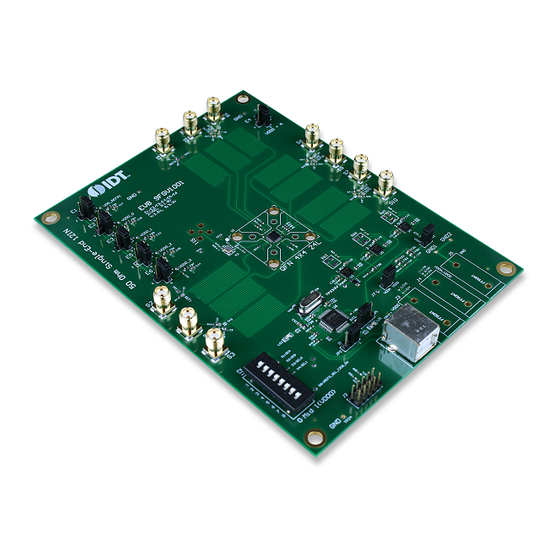
Table of Contents
Advertisement
Quick Links
Introduction
The evaluation board is designed to help the customer evaluate the 9FGV1001, 9FGV1002, and 9FGV1004 devices. When the board is
connected to a PC running IDT
different combinations of frequencies.
Board Overview
Use
Figure 1
and
Table 1
to identify: power supply jacks, USB connector, input and output frequency SMA connectors.
Figure 1. Evaluation Board Overview
10
11
12
13
©2018 Integrated Device Technology, Inc.
9FGV1001, 9FGV1002, and 9FGV1004
PhiClock™ PCIe Evaluation Board
Timing
Commander™ software through USB, the device can be configured and programmed to generate
1
8
9
2
3
4
1
User Guide
10
7
6
5
March 1, 2018
Advertisement
Table of Contents

Summary of Contents for IDT PhiClock 9FGV1001
-
Page 1: Board Overview
Introduction The evaluation board is designed to help the customer evaluate the 9FGV1001, 9FGV1002, and 9FGV1004 devices. When the board is connected to a PC running IDT Timing Commander™ software through USB, the device can be configured and programmed to generate different combinations of frequencies. -
Page 2: Board Power Supply
Alternative I C interface connector for Aardvark. C Interface Connector IDT Timing Commander can also use Aardvark. Connect this USB to your PC to run IDT Timing Commander. USB Connector The board can be powered from the USB port. Connect to 1.8V, 2.5V or 3.3V for the output voltage of Output Power Supply Jack the device. -
Page 3: Dip Switch (U2)
9FGV1001, 9FGV1002, and 9FGV1004 PhiClock™ PCIe Evaluation Board User Guide DIP Switch (U2) Refer to Figure 2 Table 2 for the DIP switch settings and functions. Figure 2. DIP Switch (U2) Table 2. DIP Switch Settings Switch Number Function 1 = OEA See datasheet. -
Page 4: On-Board Crystal
9FGV1001, 9FGV1002, and 9FGV1004 PhiClock™ PCIe Evaluation Board User Guide Figure 3. Connecting to a Computer via USB Port J6 On-board Crystal A 25MHz crystal is installed on the board and is used as the reference frequency. The board can also be modified to insert an external reference clock into the XIN pin using SMA connector S11. - Page 5 9FGV1001, 9FGV1002, and 9FGV1004 PhiClock™ PCIe Evaluation Board User Guide The circuit is designed for maximum flexibility when testing all possible logic types. Default assembly uses a 0.1μF capacitor in place of R14 and R16, and the short across R14 and R16 is cut. No other devices are assembled. This simple AC-coupled configuration allows for testing phase noise and jitter of all possible logic types.
- Page 6 9FGV1001, 9FGV1002, and 9FGV1004 PhiClock™ PCIe Evaluation Board User Guide Schematics Figure 5. 9FGV100x Evaluation Board Schematic – page 1 ©2018 Integrated Device Technology, Inc. March 1, 2018...
- Page 7 9FGV1001, 9FGV1002, and 9FGV1004 PhiClock™ PCIe Evaluation Board User Guide Figure 6. 9FGV100x Evaluation Board Schematic – page 2 ©2018 Integrated Device Technology, Inc. March 1, 2018...
- Page 8 9FGV1001, 9FGV1002, and 9FGV1004 PhiClock™ PCIe Evaluation Board User Guide Figure 7. 9FGV100x Evaluation Board Schematic – page 3 ©2018 Integrated Device Technology, Inc. March 1, 2018...
- Page 9 9FGV1001, 9FGV1002, and 9FGV1004 PhiClock™ PCIe Evaluation Board User Guide Figure 8. 9FGV100x Evaluation Board Schematic – page 4 ©2018 Integrated Device Technology, Inc. March 1, 2018...
-
Page 10: Ordering Information
IDT or any third parties. IDT's products are not intended for use in applications involving extreme environmental conditions or in life support systems or similar devices where the failure or malfunction of an IDT product can be rea- sonably expected to significantly affect the health or safety of users. - Page 11 Mouser Electronics Authorized Distributor Click to View Pricing, Inventory, Delivery & Lifecycle Information: IDT (Integrated Device Technology) EVK9FGV1001 EVK9FGV1004 EVK9FGV1002 EVK9FGV1001Q5 EVK9FGV1002Q5 EVK9FGV1004Q5...









Need help?
Do you have a question about the PhiClock 9FGV1001 and is the answer not in the manual?
Questions and answers